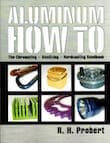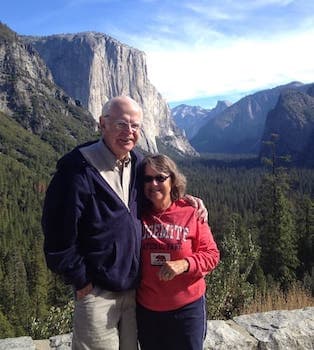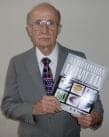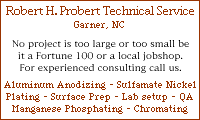
-----
Clear anodize has a yellow tint
Readers who would like a quick introduction to anodizing, please see our "Intro to Anodizing".
The aluminum oxide formed by anodizing aluminum is nearly transparent, but most anodizing is done on alloys -- not ultrapure aluminum -- and only the aluminum itself anodizes; the other materials in the aluminum alloy will discolor it proportional to how much of them is in the alloy, and how thick the anodized layer is.
Q. Hello finishing.com family
Due to a certain project's needs, we are looking to completely prevent or decrease the yellow tint on 5052-H32 alloy in type 2 anodizing.
Detailed information:
We are performing type 2 anodizing (sulfuric acid ~21%) on 5052 sheets and they come out with -sometimes slight yellow tint which seems to be the expected outcome for this specific alloy.
Operating details are;
- Etching: NaOH, 50~60 °C (122~140 °F), 30 sec
- Desmutting: Nitric Acid, Room Temp, 1 min
- Anodizing: Sulfuric Acid (21~22%), 70 °F, 15V, 45 min
Company prefers to operate with constant voltage instead of constant current.
Our target is to obtain around 20 microns (0.7 mil) film thickness.
Under these conditions, we have tried following solutions but we are yet to hit the target for this project.
- Anodizing temp: 5 °C (41 °F), 25 °C (77 °F) in combinations with 16V, 20V.
- Check for any contamination or below-par desmutting and confirm they are clean
- Check for excess of ions in anodizing tank that might get in the anodic oxide layer.
We are thinking that yellow tint is a result of either Mg or Cr in the alloy, so we are looking to see if there is any way to pull the ions (Mg2+, Cr3+) or the oxides (MgO, Cr2O3) from the surface in anodizing process.
We were thinking to implement EDTA 0.1M or Nitric Acid dipping after the anodizing tank to see if the situation will improve. Has anyone tried these approaches?
Do you have any other solution you can offer us?
Is there any hope in solving this without changing the alloy?
Thank you for reading my long question.
- Seoul
August 8, 2025

Aluminum How-To
"Chromating - Anodizing - Hardcoating"
by Robert Probert
Also available in Spanish
You'll love this book. Finishing.com has sold almost a thousand copies without a single return request :-)
A. Hi Kim.
While we await someone with more extensive experience with this problem, all I can suggest is to minimize etching, maximize desmutting, and minimize anodizing thickness.
0.7 mils is quite thick for Type 2 anodizing, and we usually only see that thickness when full saturation of black dye is required, or for architectural anodizing, not for clear anodizing. Is there a functional or wear reason it needs to be that thick?
(A point you recognize, but which should be clarified to not mislead newbies reading this, is that 'constant voltage' doesn't mean you can start at 15V (non-anodized aluminum has very low resistance and would burn⇦ huh?).
Luck & Regards,

Ted Mooney, P.E. RET
Striving to live Aloha
finishing.com - Pine Beach, New Jersey
Ted is available for instant help
or longer-term assistance.
⇩ Related postings, oldest first ⇩
Q. We are having an issue with clear anodize showing a slight yellow tint. The bath is straight sulfuric without additives at 70 °F. The coating thickness is 0.4 to 0.6 mils. We have tried three different seals with the same results. I think this is a new problem but cannot say for sure. It only became an issue because of a highly cosmetic application.
Chris Jurey, Past-President IHAALuke Engineering & Mfg. Co. Inc.
Wadsworth, Ohio

May 18, 2015
A. Many common alloys such as 2024 and 7075 will anodize yellowish due to other metals such as copper which are present. The best you can do with alloys containing copper is to anodize only to the minimum acceptable thickness.
In order to get a perfectly colorless anodize, use high purity alloys like 1000.

Jeffrey Holmes, CEF
Spartanburg, South Carolina
A. Let us know whether the metal has been tumbled or sanded or blasted in any way.

Robert H Probert
Robert H Probert Technical Services
Garner, North Carolina

Q. The material is sheet 5005. We have to peel off the protective plastic before we anodize the parts.
Chris Jurey, Past-President IHAALuke Engineering & Mfg. Co. Inc.
Wadsworth, Ohio

A. We anodize a ton of 5000 series Al (5052 H-32 to be precise). Our spec is 19 µm - 25 µm, so about twice what you're putting on, and it's always got a off yellow/goldish tint. So I'm not surprised that you're seeing a slight yellowish color shade at your coating thickness.
Is this a new issue you're seeing, whereas you've anodized this particular sheet Al before and had the desired results, or is this a new project?

Marc Green
anodizer - Boise, Idaho
Q. This is a new application. Our customer claims two other anodize suppliers do not have this issue.
Chris Jurey, Past-President IHAALuke Engineering & Mfg. Co. Inc.
Wadsworth, Ohio

A. Hi. From book knowledge only, my bet is it is possible to aggravate the problem through too aggressive etching, ameliorate the problem somewhat through best choices in desmutting practice, but not solve it. Although 5005 is significantly purer than 5052, and your thickness is less than Marc's, 0.0004" to 0.0006" is still pretty heavy for clear anodize and I'm confident that Marc is right. Maybe try a sample at .0001" to .0002" just to prove it's less yellow.
Regards,

Ted Mooney, P.E. RET
Striving to live Aloha
finishing.com - Pine Beach, New Jersey
Ted is available for instant help
or longer-term assistance.
A. If you are unable to follow Teds recommendation due to a thickness spec you're being held to, I'm confident, based on my experience with the 5052 we run, that if you lower your tank temperature into hardcoat range (30 °F), but apply the same current density for Type II (12-ASF or so), that your parts will lose the yellow color, and look more light gray-ish.

Marc Green
anodizer - Boise, Idaho
A. I'd minimize the etch if you are doing an etch step, and make certain the desmut is up to snuff.

Jeffrey Holmes, CEF
Spartanburg, South Carolina
Q, A, or Comment on THIS thread -or- Start a NEW Thread